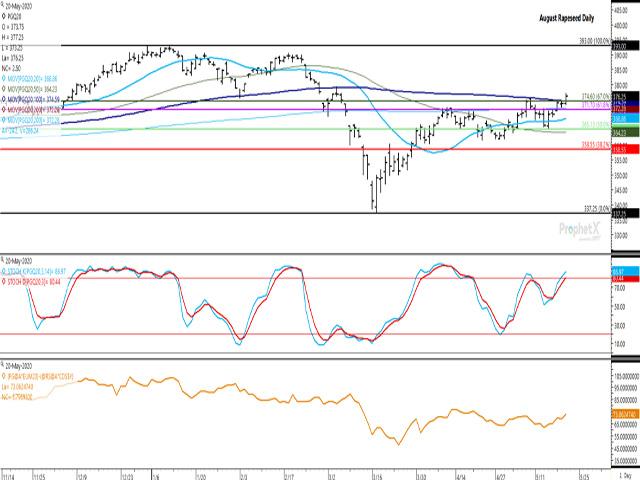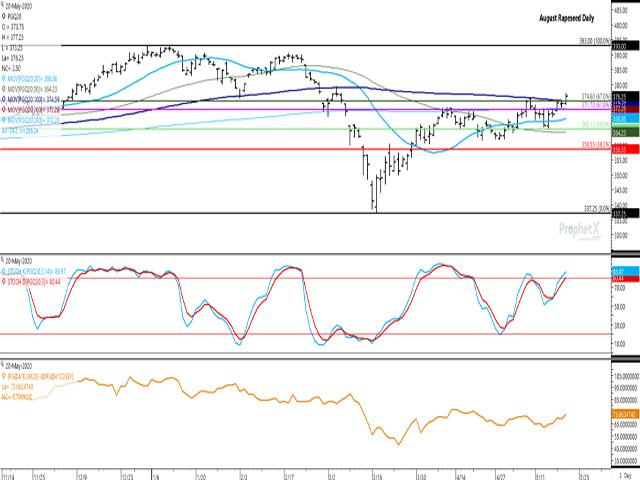Canada Markets
New-Crop Rapeseed Breaks Above Resistance
On May 19, we looked at the new-crop November canola contract, which closed higher for the 10th consecutive session while a modestly higher close on May 20 makes it 11 sessions. The May 20 high of $480.40/metric ton was met with resistance from the high reached in the previous day's trade, as traders showed signs of hesitation at levels near resistance.
At the same time, new-crop rapeseed trade on the Euronext market has showed signs of strength, breaking above resistance on Wednesday, while reaching its highest trade since March 5. The gain of 2.50 euros resulted in a move above the contract's 100-day moving average at EUR 374.59/metric ton, the first close above this resistance since Feb. 26 or almost three months. Wednesday's high reached the highest trade in more than 10 weeks.
Wednesday's close was also above the 67% retracement of the move from the January high to the March low, clearing the way for a further move to the highs reached earlier in 2020. Prior to this session's move, this contract has seen trading in a sideways direction, holding within a EUR13.75 range over a six-week period.
This move comes at a time when the euro is gaining strength against the United States dollar, showing the potential of posting a weekly gain for the first time in three weeks, a bearish factor for commodities designated in euros.
P[L1] D[0x0] M[300x250] OOP[F] ADUNIT[] T[]
Perhaps trumping the bearish news is a DTN forecast pointing to limited prospects for rainfall in much of Europe for the next 10 days.
This month, the JRC Mars Bulletin released by the European Union has revised yield potential for several crops due to dry conditions, "most markedly for rapeseed, winter barley and winter wheat."
This European report estimates rapeseed yield to fall by 4.4% from 2019, with 12 of 21 countries listed forecast to see yields fall below their respective five-year average, including France, where yield is forecast to fall by 8.9% below average.
While European production was earlier forecast to rebound in 2020, with one forecast found from December calling for production of 18.5 mmt, up from the USDA's current 16.8 mmt estimate for 2019-20, a more recent Oil World forecast is calling for a 16.7 mmt crop. This is a 14-year low, released prior to recent dry weather concerns. The May USDA report forecast 17 mmt of production, while forecasting 2020-21 imports would rise by 200,000 mt from the current crop year to 6 mmt.
The USDA's import demand forecast was despite the slowing economy due to the COVID-19 lockdowns, which will negatively affect biodiesel demand.
The Canadian Grain Commission reports that 1.390 mmt of Canadian canola has been shipped to Western Europe in the August-through-March period, representing 21.7% of 2019-20 exports over this period. This is up from 257,300 mt in 2018-19 and the three-year average of 376,767 mt. As of week 46 of the European Union's 2019-20 crop year, Canadian imports have accounted for 28.4% of total crop year imports (July 1-June 30).
Cliff Jamieson can be reached at cliff.jamieson@dtn.com
Follow him on Twitter @Cliff Jamieson
© (c) Copyright 2020 DTN, LLC. All rights reserved.






Comments
To comment, please Log In or Join our Community .